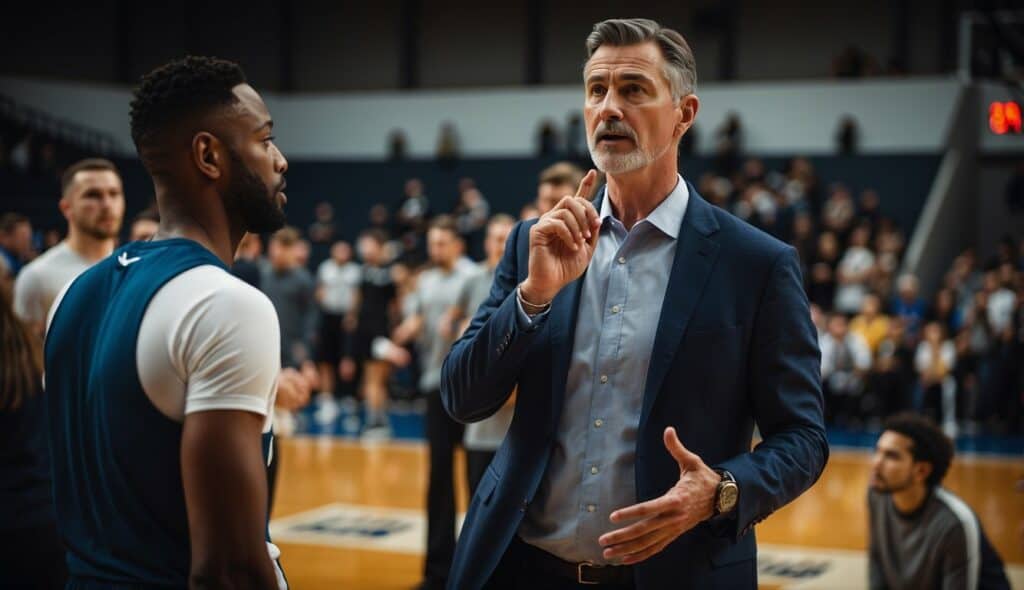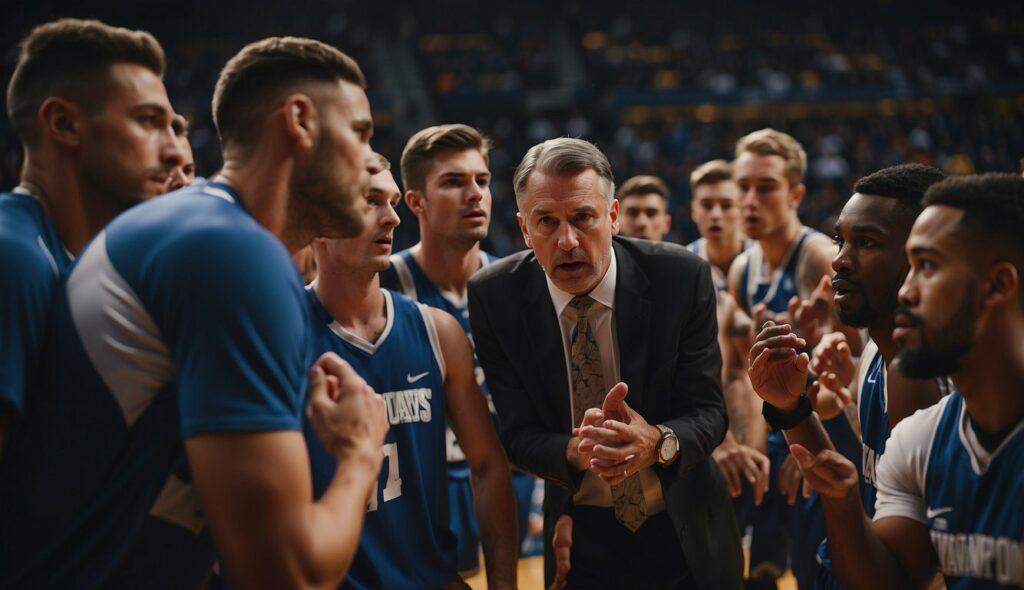Here’s How College Basketball Timeouts Work
Understanding how college basketball timeouts work is essential for fans of the game. We often see coaches calling for timeouts at critical junctures, but there’s more to timeouts than just providing a break in play. In NCAA basketball, timeouts serve a strategic purpose for teams to plan, regroup, or even stop the opposing team’s momentum. The use of timeouts is governed by specific rules which dictate the number, length, and type of timeouts that can be used during a game.

Each team is allocated a certain number of timeouts which can be used at any moment during the match, with the opportunity to save some for the latter half if they’re not used in the first. The rules differ slightly for televised games, where the length and number of timeouts are adjusted to accommodate media schedules. These timeouts are often instrumental in changing the course of the game, allowing teams to make tactical adjustments, and giving players a moment to rest.
Key Takeaways
- Timeouts are strategically used in college basketball for various tactical purposes.
- Teams must adhere to the NCAA’s timeout rules regarding number and duration.
- Proper timeout management can influence the outcome of crucial game moments.
Overview of Timeouts

As we dive into the workings of college basketball, it’s essential to understand how timeouts function. They’re a critical part of the game’s strategy and flow, giving teams moments to plan, rest, and regroup.
Types of Timeouts
- Full Timeouts: Typically last a bit longer and provide an extended break.
- 30-Second Timeouts: Shorter breaks for quick discussions or adjustments.
- Media Timeouts: Automatically occur at the first dead ball after 16, 12, 8, and 4 minutes of each half in televised games.
Length of Timeouts
- 20-Second Timeouts: Once a common term, have been replaced by the 30-second timeout.
- Full Timeouts: Usually last 60 seconds, but the length can vary.
- Media Timeouts: Generally take 75 seconds but can be extended for television.
In college basketball, the timing of timeouts is finely regulated, ensuring fair play and consistent breaks for athletes during the game. Keep this table handy for a quick reference:
| Timeout Type | Duration | Notes |
|---|---|---|
| Full Timeout | 60 seconds | Used for extended strategy discussions or rest. |
| 30-Second | 30 seconds | For quick adjustments. |
| Media | 75 seconds | Occurs at set points unless superseded by team-called TO. |
Remember, the rules can be tweaked slightly depending on whether the game is televised or not.
Rules and Regulations

In college basketball, timeouts are critical for strategy and can turn the tide of a game. We’re here to break down the specifics on how they work so you can get the full picture.
How to Call a Timeout
- Visual or oral signal: The head coach can call a timeout when their team has control of the ball. To do this, they must give a visual or oral signal that the referees recognize.
- Players on the court: Players in the game can also call timeouts during live-ball situations as long as they have possession or if the ball is dead.
Restrictions and Penalties
Timeout Allowances:
- Regular game: Teams may have a set number of timeouts available during a game. Any unused timeouts typically carry over into overtime.
- Overtime: In overtime, each team gets an additional 30-second timeout (TV Timeouts In College Basketball).
Using timeouts wisely: Squandering timeouts can lead to a lack of strategic opportunities later in the game, so it’s imperative to use them judiciously.
Penalties for improper use:
- Excessive timeouts: A team calling a timeout when none remain is penalized. This results in a technical foul, giving the opposing team free throws and possession of the basketball (Timeout Rules).
- Delay of game: Misuse of timeouts for reasons other than strategy, like disrupting the flow of the game, can attract penalties.
By understanding these rules, we can appreciate the thought processes coaches and players go through when considering a timeout.
Strategies for Using Timeouts
In the high-energy world of college basketball, timeouts are a crucial tool in a coach’s strategic arsenal. They allow teams to halt play, adjust their approach, and address specific situations on the floor.
When Coaches Call Timeouts
- Situational Awareness: We call timeouts when we need to halt the opponent’s momentum or when a game is slipping away from us. This can be crucial after a scoring run from the opposition.
- Strategy Adjustment: Timeouts give us a chance to change our defensive or offensive strategies. For example, if we’re facing a full-court press that’s causing turnovers, a timeout lets us gather our thoughts and plan a counter-attack.
Impact on Game Momentum
- Halting Opponent’s Run: When the other team is on a scoring spree, calling a timeout can disrupt their rhythm and give our players a mental break.
- Energy Management: We also use timeouts to give our players a brief rest, ensuring they have the energy to perform at their best, especially in the final minutes.
Using timeouts effectively can be the difference between a win and a loss. We strategically choose these moments to regroup, inspire our team, and shift the direction of the game.
Statistics and Timeout Usage

When digging into the nitty-gritty of college basketball, it’s essential to understand how timeouts are not only a pause in play but a tactical tool. Coaches and teams utilize timeout data to strategize and potentially influence the game’s outcome.
Timeout Trends
We’ve noticed some consistent patterns in timeout allocation. For non-televised games, teams get a combination of full and 30-second timeouts, which can be carried over into the second half if unused.
Televised games introduce TV timeouts, adding another layer to the strategy, as these breaks come at predetermined intervals. Teams must adapt to these TV Timeout rules when mapping out their game plans.
- Full Timeouts: Generally, four per team in non-televised games
- 30-second Timeouts: Typically, two per team in non-televised games
- Carryover: Unused timeouts from the first half can be used in the second half
Analysis of Timeout Efficiency
We’ve seen studies attempting to pinpoint the impact of timeouts on a game’s flow and results. One such analysis of timeout calling paints a picture of timeouts as a double-edged sword.
Their timing and frequency are crucial, potentially disrupting an opponent’s momentum or allowing a team to regroup. Here’s what we’ve observed:
- Strategic Use: Coaches call timeouts tactically to disrupt opponents’ rhythm or to halt a losing streak.
- Moment of Reflection: Timeouts offer a critical break for players to receive coaching input and adjust their approach.
By looking at timeouts through the lens of statistics and meticulous analysis, we start to appreciate the depth they add to the collegiate basketball experience.
Timeout Management in Crucial Moments
When we’re watching a college basketball game, timeouts are more than just a quick break—they’re strategic tools that coaches use to shift the tide of the game. In crucial moments, managing timeouts can be the make-or-break factor.
- Stopping Momentum: Opponents may go on a scoring run, and we know that a well-timed timeout can interrupt their rhythm, giving our team a chance to regroup.
- Rest and Recovery: During intense stretches, our players are pushing the limits. A timeout gives them those precious moments to catch their breath and recover, so they can maintain peak performance.
- Strategic Adjustments: Sometimes, the game’s on the line, and we need to change our approach. Coaches use timeouts to impart key instructions and make crucial adjustments to our strategy.
Here’s a quick rundown of how smart teams use their timeouts:
- Defensive Reorganization: When defense starts to crumble, a timeout let’s us reassess and reinforce our defensive strategies.
- Offensive Plays: We’ve got a chance to draw up a play that could lead to a score, swinging morale in our favor.
- Late-Game Scenarios: As the clock winds down, controlling the game’s pace is essential. By calling a timeout, we can make sure we have the right players on the court and take that crucial shot or secure the ball.
Timeouts are a finite resource. We can’t just call them whenever we want; we need to recognize those pivotal moments where they’ll have the maximum impact. It’s all about reading the game and knowing when that pause could help our team pivot towards victory.
